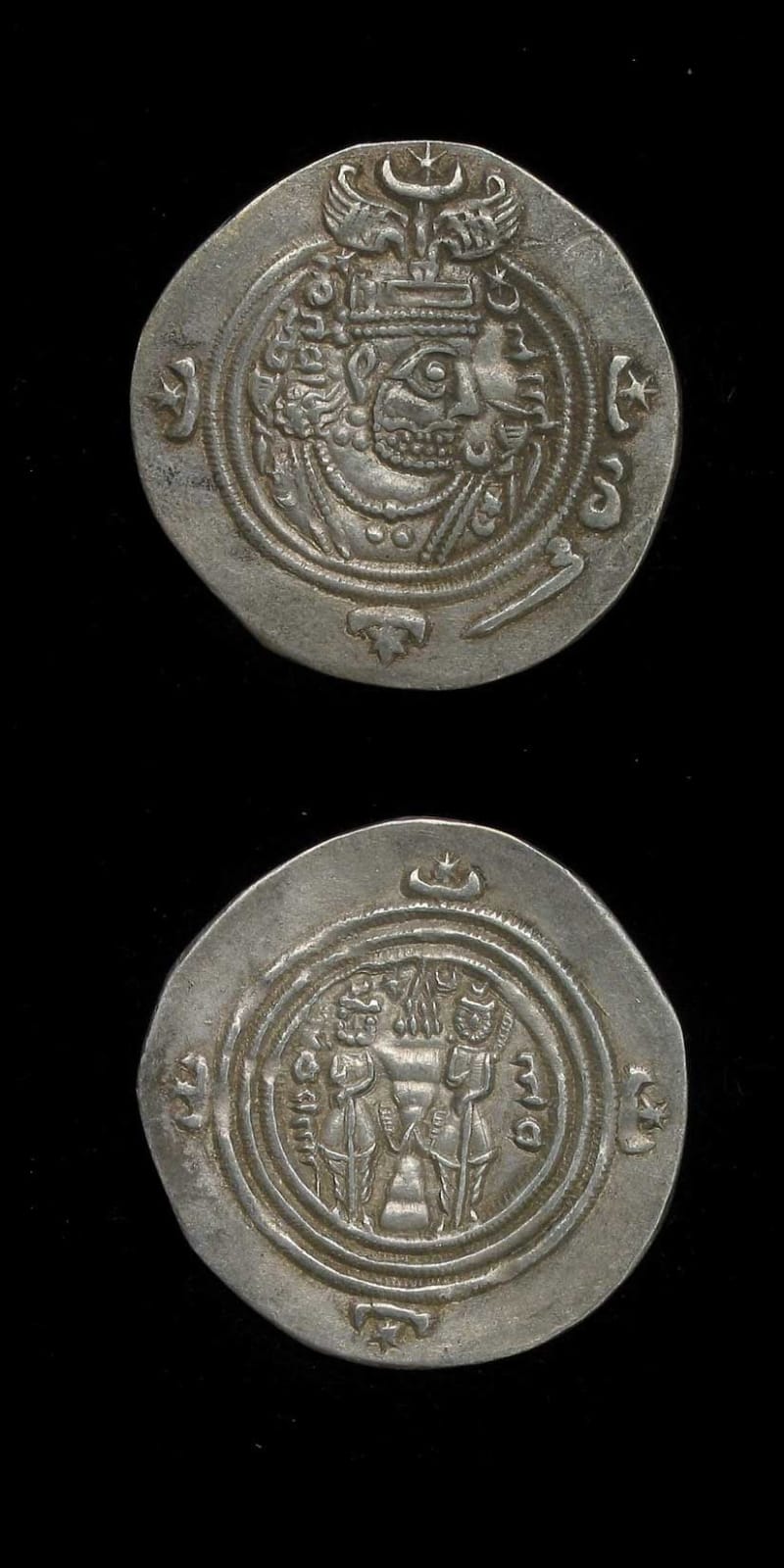Sassanid Silver Drachm of King Khosrow II, 591 CE - 628 CE
Silver
C.6979
Further images
Obverse: Bust of the Emperor Facing Right, Surrounded by Title Reverse: Two Priests Attending to a Flaming Altar in Between The In 244 A.D., Ardeshir I founded the Sassanid Dynasty,...
Obverse: Bust of the Emperor Facing Right, Surrounded by Title
Reverse: Two Priests Attending to a Flaming Altar in Between The
In 244 A.D., Ardeshir I founded the Sassanid Dynasty, the last native Persian Kingdom to rule Ancient Iran before the Islamic conquest. The Sassanid era was a golden age of Persian culture that witnessed the revival of Zoroastrianism, an ancient mystical religion native to these lands, and a literary Renaissance spurred by the translation of many Old Persian epics recorded in cuneiform into the Middle Persian language of Pahlavi written in an alphabet derived from Aramaic. By introducing heightened international trade and commerce they created a legacy of political and economic diplomacy. They sponsored trade with the Romans (later on the Byzantines), their archenemy, to the west and the Chinese to the east. Excavations in China have unearthed gold and silver Sassanid coins covering a span of many centuries until the demise of the Empire during the reign of Khosrow II. However, the fall of the Empire had already started with a series of wars waged under the rule of Khosrow I, the father of Khosrow II. Challenged by the intensification of the same international commerce that had bore such wealth, struggles for national power and international prestige had escalated to an ungovernable degree. In the face of threats to his royal house, Khosrow II embarked upon military campaigns that would prove unsuccessful. By the close of his reign, the once mighty Sassanid Empire came to an end, paving the way for the rise of Islam in the Middle East.
How many hands have touched a coin in your pocket or your purse? What eras and lands have the coin traversed on its journey into our possession? As we reach into our pockets to pull out some change, we rarely hesitate to think of who touched the coin before us, or where the coin will venture to after us. More than money, coins are a symbol of the state that struck them, of a specific time and place, whether contemporary currencies or artifacts of a long forgotten empire. This stunning hand-struck coin reveals an expertise of craftsmanship and intricate sculptural details that are often lacking in contemporary machine-made currencies. More than just a memorial commemorating a ruler, this coin is a gorgeous artifact, passed down from the hands of civilization to civilization, from generation to generation, revealing the glorious triumph of a lost civilization.
Reverse: Two Priests Attending to a Flaming Altar in Between The
In 244 A.D., Ardeshir I founded the Sassanid Dynasty, the last native Persian Kingdom to rule Ancient Iran before the Islamic conquest. The Sassanid era was a golden age of Persian culture that witnessed the revival of Zoroastrianism, an ancient mystical religion native to these lands, and a literary Renaissance spurred by the translation of many Old Persian epics recorded in cuneiform into the Middle Persian language of Pahlavi written in an alphabet derived from Aramaic. By introducing heightened international trade and commerce they created a legacy of political and economic diplomacy. They sponsored trade with the Romans (later on the Byzantines), their archenemy, to the west and the Chinese to the east. Excavations in China have unearthed gold and silver Sassanid coins covering a span of many centuries until the demise of the Empire during the reign of Khosrow II. However, the fall of the Empire had already started with a series of wars waged under the rule of Khosrow I, the father of Khosrow II. Challenged by the intensification of the same international commerce that had bore such wealth, struggles for national power and international prestige had escalated to an ungovernable degree. In the face of threats to his royal house, Khosrow II embarked upon military campaigns that would prove unsuccessful. By the close of his reign, the once mighty Sassanid Empire came to an end, paving the way for the rise of Islam in the Middle East.
How many hands have touched a coin in your pocket or your purse? What eras and lands have the coin traversed on its journey into our possession? As we reach into our pockets to pull out some change, we rarely hesitate to think of who touched the coin before us, or where the coin will venture to after us. More than money, coins are a symbol of the state that struck them, of a specific time and place, whether contemporary currencies or artifacts of a long forgotten empire. This stunning hand-struck coin reveals an expertise of craftsmanship and intricate sculptural details that are often lacking in contemporary machine-made currencies. More than just a memorial commemorating a ruler, this coin is a gorgeous artifact, passed down from the hands of civilization to civilization, from generation to generation, revealing the glorious triumph of a lost civilization.





